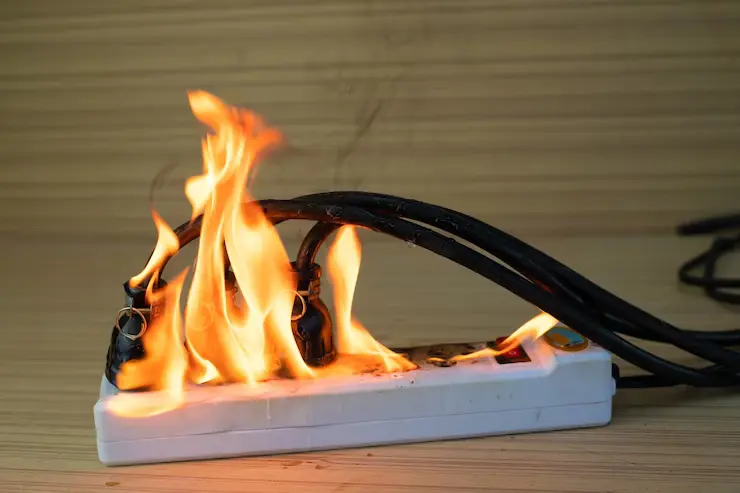What Causes Electrical Fires in Homes: 10 Main Causes
6 min read
Last Updated on August 23, 2023 by Jonathan Lopez
Electrical fires in the home can be a devastating and dangerous occurrence, typically requiring Ronkonkoma fire damage restoration services. These fires are caused by various factors, including faulty wiring, overloading electrical circuits, and improper use of electrical appliances. Understanding the causes of electrical fires can help homeowners take steps to prevent them and keep their families safe.
There are several potential causes of electrical fires in the home, including:
1. Faulty light fixtures or electrical outlets
If you are experiencing problems with your light fixtures or electrical outlets, it is vital to have them inspected by a professional. Faulty light fixtures or electrical outlets can pose a serious fire hazard.
In addition, they can also cause damage to your home or office. If you suspect your light fixtures or electrical outlets are not working correctly, please contact a qualified electrician for an inspection.
2. Damaged or frayed electrical cords
If an electrical cord is damaged or frayed, it should be replaced immediately. If the cord is not replaced, it could cause a fire or electrocution. Damaged electrical cords can be a fire hazard because the insulation on the cord can be worn away, exposing the wires.
When the wires are exposed, they can quickly come into contact with each other or with other metal objects, causing a short circuit. A short circuit can cause a fire because it can create sparks that can ignite any flammable materials nearby. It can also cause electrocution if someone comes into contact with the exposed wires.
3. Old or outdated electrical components
There are many dangers associated with using old or outdated electrical components. One of the most serious dangers is the potential for fires. Outdated electrical components can overheat and start fires, quickly spreading throughout a home or business.
This is primarily a concern in older buildings where the wiring may need to be updated to the current code. Another danger is the potential for electrocution. Outdated electrical components may not have the proper insulation, which can lead to shocks or even electrocution if someone comes into contact with them.
4. Improper use of extension cords
Extension cords are designed to supply power to an appliance or piece of equipment temporarily. However, some people use extension cords as a permanent solution, which can create several safety hazards. Improper use of extension cords can lead to electrical fires, electrocution, or another serious injury.
Here are some tips for using extension cords safely:
- Only use extension cords that are rated for the voltage and amperage of the appliance or equipment you are using.
- Do not use extension cords in wet or damp locations.
- Refrain from overloading extension cords by plugging in too many appliances or equipment.
- Do not run extension cords under carpets or rugs.
- Do not use extension cords that are damaged or have frayed wires.
- Store extension cords in a dry, safe location when not in use.
5. Static electricity
Static electricity is the build-up of an electrical charge on the surface of an object. The charge remains until it is discharged to the ground or dissipated into the air. Static electricity is generated when two materials are rubbed together. The friction between the materials causes electrons to be transferred from one material to another.
The material that loses electrons becomes positively charged, while the material that gains electrons becomes negatively charged. The amount of static electricity generated depends on the type of materials used, the friction, and the humidity of the environment. Static electricity can be dangerous in certain situations.
6. Lightning
Lightning is a naturally occurring electrostatic discharge during which two electrically charged regions in the atmosphere or ground temporarily equalize themselves, causing the instantaneous release of as much as one gigajoule of energy. This release of energy causes the emission of light and usually thunder.
Lightning occurs during thunderstorms and can also result from volcanic eruptions, extremely intense forest fires, and certain large meteors as they hit the ground. The exact cause of lightning is still not fully understood, but scientists believe it is caused by the buildup of static electricity in the atmosphere.
7. Electronic equipment with faulty internal components
Electronic equipment is prone to various faults, many of which are caused by malfunctioning internal components. These faults can range from minor issues that can be easily fixed to major problems that require the replacement of the entire unit. Sometimes, the fault may be due to a manufacturing defect, and a warranty may cover the equipment.
One of the most common faults is a problem with the power supply. This can be caused by various factors, including a loose connection, a faulty power switch, or a problem with the AC power input. Another common issue is with the display, which can be caused by a defective LCD panel or an issue with the backlight.
8. Overheated electrical motors
Overheated electrical motors can cause significant damage to equipment and pose a safety hazard. When an electrical motor overheats, the windings can overheat and break down, causing a loss of power. The insulation can also break down, leading to arcing and fire.
To avoid these hazards, it is crucial to monitor the temperature of electrical motors and take steps to prevent overheating. There are several ways to prevent overheating in electrical motors.
First, make sure that the motor is properly sized for the application. If the motor is too small, it will have to work harder and will overheat. Second, keep the motor clean and free of debris. A build-up of dirt and dust can act as insulation and prevent the heat from dissipating. Third, make sure that the motor is properly ventilated. Fans and vents help to remove heat from the motor and keep it cool.
9. Faulty wiring
In many older homes, the wiring is not up to code and can pose a serious fire hazard. Faulty wiring is one of the leading causes of house fires, so it is crucial to have it inspected and replaced if necessary. If you live in an older home or one that was updated a while ago, having an electrician come and take a look at your wiring is a good idea.
They will be able to tell you if it is up to code and if any areas need to be fixed. In some cases, you may be able to do some of the work yourself, but it is always best to leave it to a professional. Fixing electrical problems yourself can be extremely dangerous and lead to serious injury or death.
Contact us today if you are looking for an experienced electrician in Oslo (Finn elektriker i Oslo) to inspect your home’s wiring and take the necessary steps to prevent an electrical fire. Our professional electricians are available to inspect your home and provide the safety advice and recommendations you need to protect your home from an electrical fire.
10. Overloaded circuits
An overloaded circuit occurs when too much electricity flows through the wires in an electrical circuit. It can happen when too many appliances or lights are turned on simultaneously or when one machine or light is drawing too much electricity.
Overloaded circuits can cause fires, so it is essential to know the signs of an overloaded circuit and how to prevent one. The first sign of an overloaded circuit is usually a blown fuse or tripped circuit breaker. This happens because the circuit carries more electricity than it is designed for, and the breaker is designed to protect the circuit from damage by breaking the flow of electricity.
Last Words!
It’s essential to prevent electrical fires in the home, such as regularly inspecting wiring and outlets, not overloading circuits, and adequately maintaining appliances. Having a working smoke detector in the house is also essential in any fire incident. To find out more about Keys For Effective Electrical Troubleshooting, click on this link.





